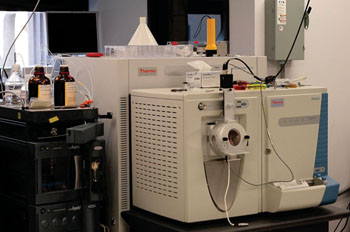Proteome-Based Marker Classifies Chronic Kidney Disease Progression
By LabMedica International staff writers
Posted on 26 Jul 2016
Chronic kidney disease (CKD) progression is currently assessed by a decline in estimated glomerular filtration rate (eGFR) and/or an increase in urinary albumin excretion (UAE) though these markers are considered either to be late-stage markers or to have low sensitivity or specificity.Posted on 26 Jul 2016
Sometimes the patients have not even been aware of their impaired renal function, until they are in need of a renal replacement therapy, either dialysis or transplantation. Then the diagnosis comes as a shock, because the patients usually learn that various interventions such as a special diet, but also medication with angiotensin-converting-enzyme (ACE) inhibitors might have delayed, perhaps even prevented, end-stage renal disease.

Image: Capillary electrophoresis–mass spectrometry apparatus (Photo courtesy of the Dovichi Group).
A large team of international scientists led by those at Mosaiques Diagnostics GmbH (Hanover, Germany) collected data from CKD patients and the cohort consisted of 2,672 patients from previous studies. Stages of CKD were defined on the basis of the eGFR, using the Chronic Kidney Disease Epidemiology Collaboration (CKD-EPI) formula. More than 75% of the patients suffered from diabetes mellitus while 280 other patients had hypertension, three had membranous glomerulonephritis, 30 had unknown CKD and 313 were healthy individuals. Sample collection and analysis of urine samples was done using capillary electrophoresis–mass spectrometry. The CKD273 classifier is a support vector machine (SVM) classification model based on the amplitudes of 273 urinary peptides, which allows the calculation of a classification score for the presence and progression of CKD.
Of these, 394 individuals displayed a decline in eGFR of more than 5 mL/min/1.73 m2/year (progressors) and the remaining individuals were considered non-progressors. For all samples, UAE values and the urinary peptide CKD273 classification scores were obtained. To assess UAE values and CKD273 scores at different disease stages, the cohort was divided according to baseline eGFRs of ≥80, 70–79, 60–69, 50–59, 40–49, 30–39 and less than 29 mL/min/1.73 m2. In addition, areas under the curve for CKD273 and UAE were calculated.
The investigators found that in early stage CKD, the urinary proteome-based classifier performed significantly better than UAE in detecting progressors. In contrast, UAE performed better in patients with late-stage CKD. No significant difference in performance was found between CKD273 and UAE in patients with moderately reduced renal function. In some patients with an eGFR more than 60 mL/min/1.73 m2 and an UAE between 30 and 300 mg/g, a rapid eGFR decline of more than 15 ml/min/1.73 m2 takes place, while in others the eGFR stays stable and the disease does not progress.
The authors concluded that their study also allowed assessment of its practical implementation: to date, more than 1,500 patients have been evaluated using CKD273 in the study. The result is obtained typically within three days, hence within a similar time frame as for albuminuria. Because the CE-MS analysis is a high-end technology, in contrast to the microalbuminuria test, the cost is higher. However, health economic calculations indicate that CKD273 classifier analysis, when used for the detection of early stage CKD, demonstrated cost-effectiveness. The study was published on July 6, 2016, in the journal NTD (Nephrology Dialysis Transplantation).
Related Links:
Mosaiques Diagnostics














